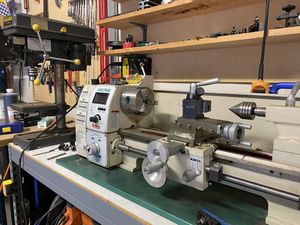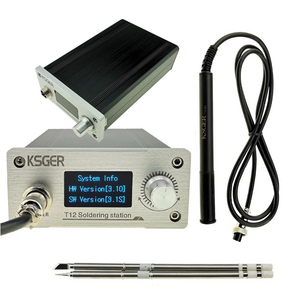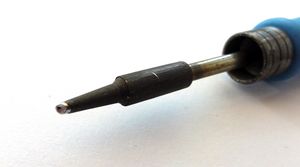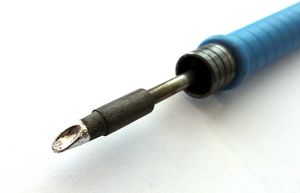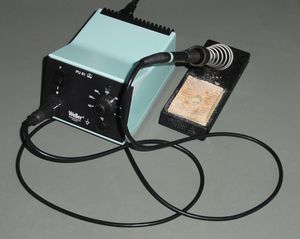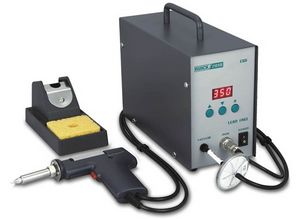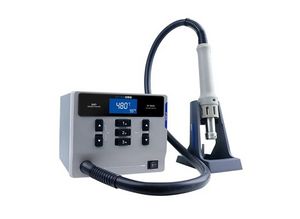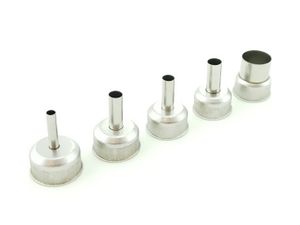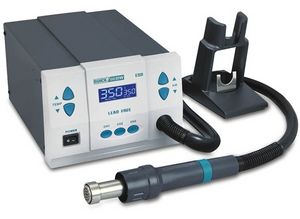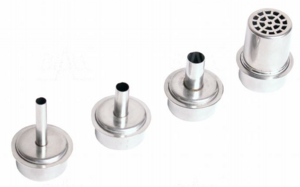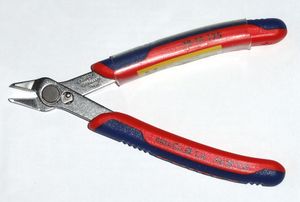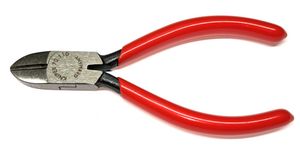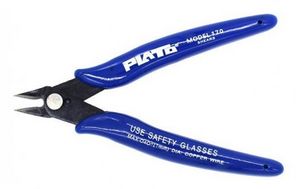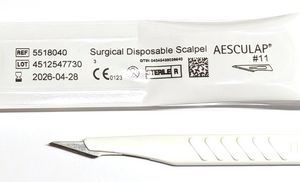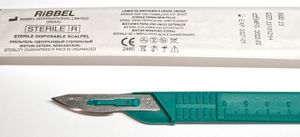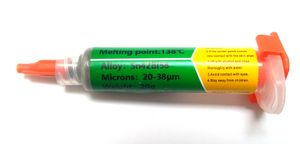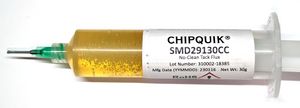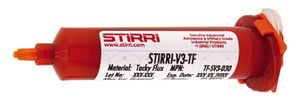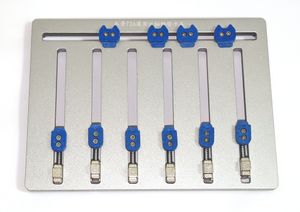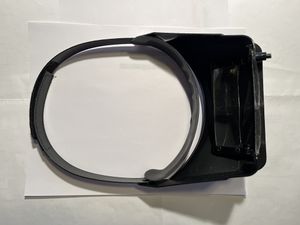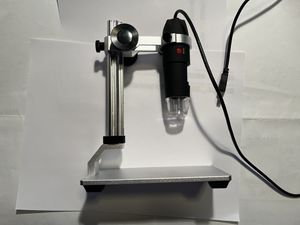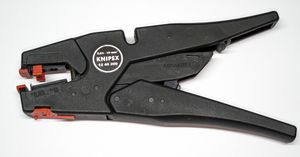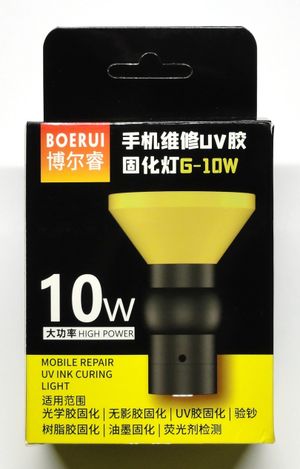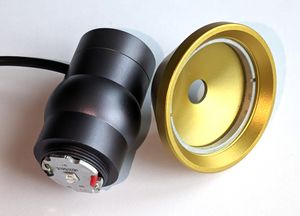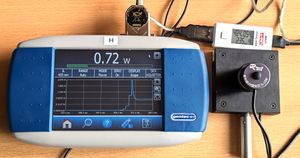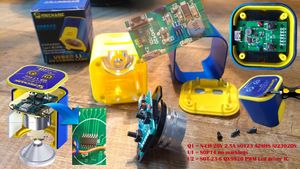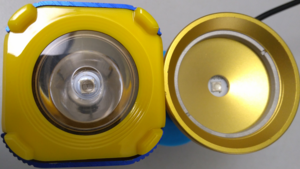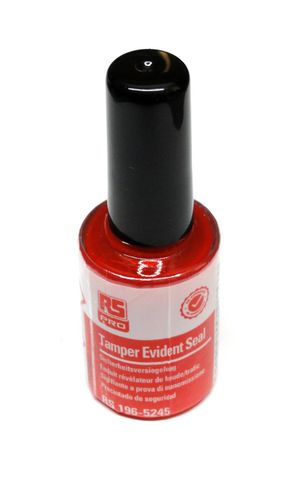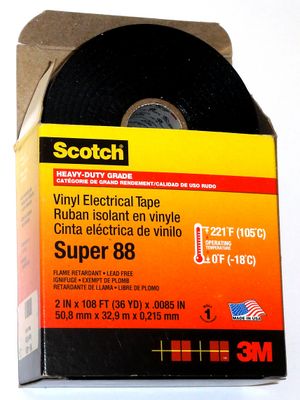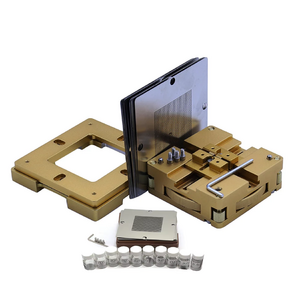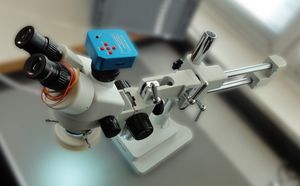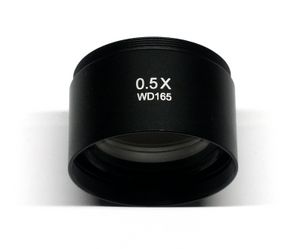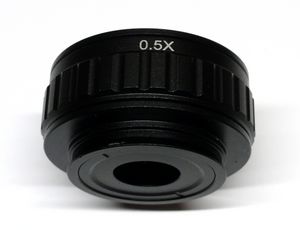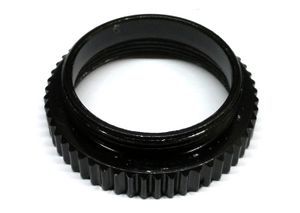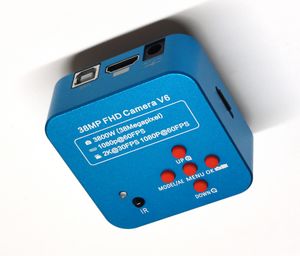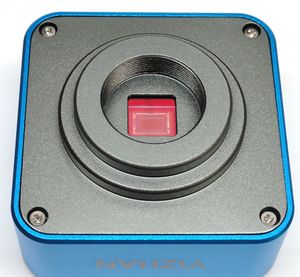Difference between revisions of "Mechanical Tools"
Jump to navigation
Jump to search
(→USB microscopes: Added several kinds of inexpensive magnification devices.) |
Polymorphic7 (talk | contribs) (More stations added) |
||
| (56 intermediate revisions by 2 users not shown) | |||
| Line 7: | Line 7: | ||
===Soldering Irons=== | ===Soldering Irons=== | ||
| + | : Ascending equipment order from cheap to more expensive. | ||
| − | ==== | + | =====KSGER T12 STM32 v3.1s===== |
| − | + | : A cheap basic soldering station that uses T12 tips. Has stand-by function using a tilt sensor in the handle to extend the life of your T12 heating element for longer lifespan of the heating element.<br> | |
| + | : Anodized aluminum case, aluminum front panel and control knob. Features a STM32 MCU, [https://github.com/dreamcat4/t12-t245-controllers-docs/tree/master/controllers/stm32-t12-oled firmware upgradable]. Great price - performance ratio.<br> | ||
| + | : While in boost mode the T12 tip should be able to output 75 W and tested it was possible to solder 18 AWG copper braided wire.<br> | ||
| + | : '''Known quirks''' are that the case is not grounded and in case of a short circuit the case becomes hot (live). User should ground the case out of the box.<br> | ||
| + | : [[File:KSGER T12 Soldering station.png|none|thumb|KSGER T12 Soldering station, STM32 mcu v3.1s]] | ||
| − | ====Weller Station==== | + | ====AiXun Soldering Station with JBC Soldering Tips==== |
| − | + | : This Chinese soldering station is compatible with JBC soldering tips (C245) and is a great station for its lowish price of around 150 bucks. The station comes with three soldering tips that should be replaced with original JBC wave-soldering tips like the C245965 (small spoon) or the C245938 (big spoon) for general purpose soldering tasks. The very low cost for this station comes with some quirks that users should be aware of: | |
| + | |||
| + | : * The most recent firmware version 1.34 displays incorrect temperature data in certain states to hide the temperature overshoot on a cold-start. Firmware downgrade is recommended to avoid being lied to. | ||
| + | : * Soldering on grounded (PE) circuit boards can cause issues with the temperature sensing and should be avoided. | ||
| + | |||
| + | : This review informs about these quirks in detail. [https://www.youtube.com/watch?v=B7jLpHgR7fI][[File:SolderingStation.JPG|none|thumb|AiXun Soldering Station with JBC Soldering Tips]] | ||
| + | |||
| + | : The "small spoon" is by far the most used soldering tip on my bench as it turns almost every soldering task into a "low/no-skill" job provided copious amounts of flux is used and the board was manufactured with solder mask. The :"shape of this tip prevents the active region to oxidize by always keeping some solder on it and thus keeping oxygen away from the metal surface of the tip. | ||
| + | : [[File:SmallSpoon.JPG|none|thumb|Original JBC Soldering Cartridge C245965 (small spoon)]] | ||
| + | |||
| + | : The "big spoon" is for all other tasks which need a little bit more contact area than the small spoon can provide. | ||
| + | : [[File:BigSpoon.JPG|none|thumb|Original JBC Soldering Cartridge C245938 (big spoon)]] | ||
| + | |||
| + | ====Weller Soldering Station PU81==== | ||
| + | : A basic soldering station for general purpose soldering tasks. Unfortunately there are no wave-soldering tips available for this type of iron. | ||
| + | : [[File:Weller.JPG|none|thumb|Weller PU 81 Soldering Station]] | ||
| + | |||
| + | ===Desoldering Stations (THT)=== | ||
| + | : Ascending equipment order from cheap to more expensive. | ||
| + | |||
| + | ====ZD-915==== | ||
| + | : A cheap entry level hobbyist station. It works good, but the build quality is backed up by the price. The build quality is not a lot (you get what you pay for).<br> | ||
| + | : However spare parts are readily available and are extremely cheap. The heating element in the gun handle gets a lot of play on it if you plan on using it for some serious amount of work in no time.<br> | ||
| + | : The gun handle parts are all made from cheaper plastic. The handle is not fiberglass reinforced plastic but some kind of ABS plastic. | ||
| + | : Besides that I think this station still performs nice if you plan to use it only for prototypes or hobby projects.<br> | ||
| + | : [[File:Zd915.jpg|none|thumb|ZD-915 desoldering station, nozzle diameter sizes are 0.8mm, 1.0mm, 1.3mm]] | ||
| + | |||
| + | ====Quick 201B ESD==== | ||
| + | : The 201B is a nice solid station that isn't going to break the bank with readily available spare parts. Heat dissipation of 90W, temprature range of 200÷450°C, ESD safe, LED display (3 digit) and good temperature stabilization.<br> | ||
| + | : The only thing it is missing is a sleep function with tilt sensor in the handle, if you don't use it turn it off it or will wear the heating element faster.<br> | ||
| + | : The station was properly tested over several years (and well over uncountable components) and used a lot. The heating element was already replaced once before and it still runs perfectly fine.<br> | ||
| + | : The gun handle feels comfortable in the hand and is made of really strong fiberglass reinforced plastic and thus more wear-resistant.<br> | ||
| + | : A good heating element measures 1.1ohms the failure mode of a bad heating element is it going open. The display will show the H-E error indicating the heating element failed.<br> | ||
| + | : Spare parts are easy to find and the replacing of the heating element was easy too. The station overal has a solid good build quality and performs well. If you do a lot of THT or recycling this is the station for you. | ||
| + | : [[File:Quick 201b.jpg|none|thumb|Quick 201b desoldering station, nozzle diameter sizes are 0.8mm, 1.0mm, 1.3mm]] | ||
| + | |||
| + | ===Hot Air Stations=== | ||
| + | : Ascending equipment order from cheap to more expensive. | ||
| + | |||
| + | ====Atten ST-862D==== | ||
| + | : The Atten ST-862D hot air soldering station has an extremely high power of 1000W. This makes sure that the soldering station reaches the operating temperature quickly.<br> | ||
| + | : Due to the two temperature buttons, the temperature is easily set between 100℃ and 480℃ and due to three shortcuts it makes it possible to save temperatures.<br> | ||
| + | : The temperature can be seen on the LED display. Additionally, the air flow can be adjusted by the air keys.<br> | ||
| + | : The hot air station is convertible with straight and spiral air, has a auto-sleep function and a heating element overheating detection. | ||
| + | : Cheaper station that "beats" the Quick. I have used this station myself for a short period, it's nice. But the build quality seems a little less than Quick. | ||
| + | : [[File:Atten st-862d.jpg|none|thumb|Atten ST-862D, 1000 Watt, 100℃-480℃,120L/min(Max)]] | ||
| + | : [[File:Nozzles atten st862d.jpg|none|thumb|4 nozzles (5.0mm (A-2605), 6.4mm (A-2664), 8.0mm (B-2608), 10.0mm (B-2610)), | ||
| + | 1 conversion nozzle]] | ||
| + | |||
| + | ====Quick 861DW ESD==== | ||
| + | : The Quick 861DW ESD is an inexpensive hot air station with a high power of 1000 watt and it has a maximum airflow of 120 litres per minute. This device is designed for soldering SMD components such as SOIC, QFP, PLCC, CHIP and BGA.<br> | ||
| + | : Furthermore, the Quick 861DW is also suitable for drying, removing paint, melting, heating and disinfecting surfaces. Due to the high power and a ceramic heating element, rapid heating to the desired temperature is possible.<br> | ||
| + | : The 861DW ESD has three channels where the temperature and the amount of airflow can be set and these settings can be memorized by the device. | ||
| + | : Been using this station myself for many years the caramic heating element did not fail yet. A solid station with nice build quality. Atten is cheaper but the compromise is on the build quality. | ||
| + | : [[File:Quick 861dw.jpg|none|thumb|Quick Quick 861DW ESD, Ceramic heater, 1000 Watt, 100°C-500°C, 50 l/min]] | ||
| + | : [[File:Nozzles quick 861d.png|none|thumb|Nozzle diameter sizes are 5,0mm, 6,4mm, 8,4mm]] | ||
===Tweezers=== | ===Tweezers=== | ||
| − | Manipulating PCBAs often involves handling small and/or hot components while soldering. Most types of tweezers are made of some kind of steel, which can make them susceptible to get magnetized, which is not ideal if that is not done intentionally by using a magnetize tool. This accidental magnetization can be avoided by using tweezers made of titanium. The minimal set of tweezers should consist of following types: | + | : Manipulating PCBAs often involves handling small and/or hot components while soldering. Most types of tweezers are made of some kind of steel, which can make them susceptible to get magnetized, which is not ideal if that is not done intentionally by using a magnetize tool. This accidental magnetization can be avoided by using tweezers made of titanium. The minimal set of tweezers should consist of following types: |
====Straight, fine tweezers==== | ====Straight, fine tweezers==== | ||
| + | : [[File:Bst-y22.jpg|none|thumb|BST-Y22 straight]] | ||
| + | |||
| + | : Titanium tweezers are great for delicate work that requires minimal grabbing force, such as holding passive components in place for soldering. Titanium is diamagnetic, which prevents (slightly) magnetized passives from clinging to it at inopportune moments. | ||
====Angled, fine tweezers==== | ====Angled, fine tweezers==== | ||
| + | : [[File:Bst-y23.jpg|none|thumb|BST-Y23 curved]] | ||
| + | |||
| + | : Titanium tweezers are great for delicate work that requires minimal grabbing force, such as holding passive components in place for soldering. Titanium is diamagnetic, preventing (slightly) magnetized passives from clinging to it at inopportune moments. This particular type has a curved tip, which helps to hold them more ergonomically. | ||
====Straight, coarse tweezers with riffles==== | ====Straight, coarse tweezers with riffles==== | ||
| − | This type of tweezers come in handy when something has to be gripped securely in order to be able to bend / shape them in a controlled manner. These tweezers have a thick metal parts that are not easily bend out of shape like the fine tweezers. | + | |
| + | : [[File:Knipex927877ESD.jpg|none|thumb|Knipex tweezer of the type 92 78 77 ESD]] | ||
| + | |||
| + | : This type of tweezers come in handy when something has to be gripped securely in order to be able to bend / shape them in a controlled manner. These tweezers have a thick metal parts that are not easily bend out of shape like the fine tweezers. | ||
====Straight, self-holding tweezers==== | ====Straight, self-holding tweezers==== | ||
| + | |||
| + | ===Side Cutters=== | ||
| + | |||
| + | ====Knipex 78 03 125==== | ||
| + | : This electronic side cutter is a great first electronic side cutter to get when starting out in tinkering with electronics. This side cutter comes without chamfers on the cutting side and is meant to cut thin/soft wire. This tool can handle cutting wires with a diameter of up to 1.6mm for Cu and 1.0mm for Fe. | ||
| + | : [[File:Knipex 7803125.JPG|none|thumb|Knipex diagonal cutter type 78 03 125]] | ||
| + | <br> | ||
| + | |||
| + | ====Knipex 70 01 110==== | ||
| + | : The side cutter that saves my electronic side cutters from becoming toothless and sad. Can handle up to 1.2mm Dia Hard Wire, 2mm Dia Medium Wire and 3.2mm Dia Soft Wire and costs about 25 bucks. | ||
| + | : [[File:Knipex7001110.jpg|none|thumb|Knipex diagonal cutter type 70 01 110]] | ||
| + | <br> | ||
| + | ====Plato model 170==== | ||
| + | : Precise, reliable cutting action at an economical price. Thin profile handle and light weight design is ideal for smaller hands.<br> | ||
| + | : Cut up to 18 AWG copper wire (.04"/1mm). Trimming in tight areas. Ergonomic handle design. Spring-back action.<br> | ||
| + | : Cheap and effective, the usual suspects also sell them. They last quite a while even when abused. | ||
| + | : [[File:Plato model 170 pliers.jpg|none|thumb|Plato model 170 side cutter]] | ||
===Scalpels=== | ===Scalpels=== | ||
| − | There are many types of straight edged and round edged scalpels beside the ones listed below. The one mentioned here are the essential types needed to attach botch wires and sniffing wires to signal tracks covered by solder mask. The fixed connection between the handle and the blade of the disposable version makes this type of scalpel a little bit more precise than the scalpel handle with exchangeable blades. Naughty people even cut through pins of ICs with scalpels to remove ICs without the use of a heat-gun, but you didn't read that here, as that dulls a blade pretty quickly and should only be used in a pinch. | + | : There are many types of straight edged and round edged scalpels beside the ones listed below. The one mentioned here are the essential types needed to attach botch wires and sniffing wires to signal tracks covered by solder mask. The fixed connection between the handle and the blade of the disposable version makes this type of scalpel a little bit more precise than the scalpel handle with exchangeable blades. Naughty people even cut through pins of ICs with scalpels to remove ICs without the use of a heat-gun, but you didn't read that here, as that dulls a blade pretty quickly and should only be used in a pinch. |
====Straight edged scalpels==== | ====Straight edged scalpels==== | ||
| − | [[Image:ScalpelNo11.jpg| | + | : [[Image:ScalpelNo11.jpg|none|thumb|Disposable scalpel with blade #11]] |
| − | The sharp tip of this type of scalpel makes it ideal to cut the conductor track without nicking nearby tracks. The blade #11 has a short, straight edge that gives good control over the cut. | + | : The sharp tip of this type of scalpel makes it ideal to cut the conductor track without nicking nearby tracks. The blade #11 has a short, straight edge that gives good control over the cut. |
====Round edged scalpels==== | ====Round edged scalpels==== | ||
| − | [[Image:ScalpelNo23.jpg| | + | : [[Image:ScalpelNo23.jpg|none|thumb|Disposable scalpel with blade #23]] |
| + | |||
| + | : The copper tracks on the top layer of a PCB are usually covered with a layer of (green) solder mask, which can be carefully scraped away from the portions of the track that are about to be soldered to say attach a wire. The round shape of the blade #23 (there are other blades with a rounded edge) allows the user to only remove the solder mask from the track of interest, which will make the soldering process later on very easy, since the remaining solder mask will prevent the solder to stick to the covered tracks. Exposing the other tracks by scraping too much solder mask away may result in a much more difficult soldering job. | ||
| + | |||
| + | ===Steel Probes=== | ||
| + | : Steel probes are handy to check soldered IC pins for bad solder joints or mixing / applying small quantities of liquid material (adhesives, uncured solder mask, etc.) in a controlled manner. | ||
| + | |||
| + | ====Straight Probe==== | ||
| + | |||
| + | =====Menda 35122===== | ||
| + | |||
| + | : [[File:Menda35122.jpg|none|thumb|Straight Steel Probe made by Menda of type 35122]] | ||
| + | |||
| + | ====Angled / curved Probes==== | ||
| + | : Mee too! | ||
| + | |||
| + | <br /> | ||
| + | |||
| + | ===Solder=== | ||
| + | |||
| + | ====Products without Pb==== | ||
| + | |||
| + | =====KEK Solder Paste 4258-138===== | ||
| + | : This exotic type of solder is for applications where the upside of its low melting point is worth its downsides in form of more brittle solder joints and potential self-desoldering of components, which make this type of solder a bad fit to use on connectors and other components that are exposed to mechanical stress in the operation. The use in power applications, where the package of components can reach the melting point of this solder, is another application where this kind of solder should not be used.[[File:Kek-solderpaste-bot.jpg|none|thumb|KEK Solder Paste 4258-138<br />Melting point: 138°C<br />Alloy: Sn42Bi58<br />Microns: 20-38um]] | ||
| + | <br/> | ||
| + | |||
| + | ====Products containing Pb==== | ||
| − | + | =====Mechanic TY-V866, d=0.2mm, 1%..3% flux===== | |
| + | : [[File:Mechanic TY-V866.jpg|none|thumb|Mechanic 0.2mm, 1%..3% flux, Rosin core<br>Melting point: 183°C]]<br /> | ||
===Soldering Flux=== | ===Soldering Flux=== | ||
| − | Soldering flux is the magic ingredient for a soldering job with many functions that makes it a breeze. It cleans and de-greases the components, promotes wetting (makes solder stick to the components instead of balling up) and reduces oxidation. The "tacky" variety also helps to keep the component in place so the usual step of "tacking down" a component can be skipped with enough soldering skill. | + | : Soldering flux is the magic ingredient for a soldering job with many functions that makes it a breeze. It cleans and de-greases the components, promotes wetting (makes solder stick to the components instead of balling up) and reduces oxidation. The "tacky" variety also helps to keep the component in place so the usual step of "tacking down" a component can be skipped with enough soldering skill. |
| + | |||
| + | ====CHIPQUIK SMD29130CC==== | ||
| + | : [[File:Chipquik SMD29130CC rev1.jpg|none|thumb|CHIPQUIK No-Clean Tack Flux SMD29130CC]] | ||
| + | |||
| + | ====STIRRI TF-V3 Flux==== | ||
| + | : [[File:STIRRI TF-V3 Flux.jpg|none|thumb|STIRRI V3-TF universal no-clean rosin-based tacky paste flux]] | ||
| + | : QcAid™ UV-Tracer, universal, high-performance, REACH-compliant.<br> | ||
| + | : '''Viscosity:''' 38-51 mPa/s (Malcom @ 10 RPM/25ºC (x 10³mPa/s)). | ||
| + | |||
| + | ===Solder Mask Products=== | ||
| + | |||
| + | ====UV curing solder mask ink==== | ||
| + | |||
| + | =====Mechanic UVH900-LY===== | ||
| + | : [[File:Mechanic-UVH900-LY.jpg|none|thumb|Mechanic UVH900-LY <br /> UV curing solder mask ink]] | ||
| + | <br /> | ||
===Soldering Fixtures / work piece holders=== | ===Soldering Fixtures / work piece holders=== | ||
====Soldering Fixtures for flat, smartphone sized PCBAs==== | ====Soldering Fixtures for flat, smartphone sized PCBAs==== | ||
| − | + | ||
| + | =====Stickvise===== | ||
| + | : [[File:Stickvise.jpg|none|thumb|Stickvise]] | ||
| + | |||
| + | : The [https://stickvise.com/ Stickvise] is a low profile vise for PCB holding and soldering. The vise can be customized with [https://www.stickvise.com/hacks/parametric-jaws parametric jaw plates]. The maximal distance between the jaws (with the supplied 6mm rod) is about 155.9mm and the jaws are about 76mm wide. The maximal distance between the jaws can be extended by using a longer 6mm rod, which is also used in optical cage systems and is therefore widely available. | ||
| + | |||
| + | =====MiJing T26===== | ||
| + | : [[File:MiJingT26.jpg|none|thumb|PCBA fixture made by MiJing of the Type T26]] | ||
| + | |||
| + | : This fixture is a reliable tool to keep PCBAs in place that have a low profile like the PCBAs of smartphones. It has a solid build quality and can be adapted to PCBAs with a higher profile by replacing the blue contact points with 3d-printed ones. The metal base plate is heavy with screwed in rubber feet to keep the fixed PCBA planted on the workbench. All parts are connected with screws, so maintenance or adaption to another application should be pretty easy. | ||
====Work piece holders for PCBAs with large TH (through hole) components==== | ====Work piece holders for PCBAs with large TH (through hole) components==== | ||
=====Panavise 333===== | =====Panavise 333===== | ||
| − | Fix me | + | : Fix me |
===Magnification devices=== | ===Magnification devices=== | ||
| − | ==== Eye Loupe ==== | + | ====Eye Loupe==== |
| − | A simple 7x eye loupe is a small, useful tool for examining small parts. There are single monocular loupes, or for a bit higher cost, head-mounted eyeglass style stereoscopic loupes which may or may not feature replaceable optics. | + | : A simple 7x eye loupe is a small, useful tool for examining small parts. There are single monocular loupes, or for a bit higher cost, head-mounted eyeglass style stereoscopic loupes which may or may not feature replaceable optics. |
| − | ==== Headband magnifier ==== | + | ====Headband magnifier==== |
| − | There are many kinds of head-mounted stereoscopic or single-element magnifying devices available. Some are equipped with LED lights, which is handy but not strictly necessary. The picture below shows one that was purchased from a discount tool store for less than US$10. | + | : There are many kinds of head-mounted stereoscopic or single-element magnifying devices available. Some are equipped with LED lights, which is handy but not strictly necessary. The picture below shows one that was purchased from a discount tool store for less than US$10. |
| − | [[File:Headband magnifier.jpg|none|thumb|headband magnifier]] | + | : [[File:Headband magnifier.jpg|none|thumb|headband magnifier]] |
<br /> | <br /> | ||
====USB microscopes==== | ====USB microscopes==== | ||
| − | A microscope is handy for examining small parts or PCB traces. There are many inexpensive ones available. A stand is very useful as well for both precise positioning and to keep the camera steady. | + | : A microscope is handy for examining small parts or PCB traces. There are many inexpensive ones available. A stand is very useful as well for both precise positioning and to keep the camera steady. |
| − | [[File:USB microscope with stand.jpg|none|thumb|USB microscope with stand]] | + | : [[File:USB microscope with stand.jpg|none|thumb|USB microscope with stand]] |
<br /> | <br /> | ||
| + | |||
| + | ===Wire Strippers=== | ||
| + | |||
| + | ====Knipex 12 40 200==== | ||
| + | : Probably the last general purpose wire stripper you'll buy, costing about 50 bucks. | ||
| + | : [[File:Knipex1240200.jpg|none|thumb|Knipex 12 40 200<br>self-adjusting wire stripper<br>7-32 AWG, 0.03mm2..10mm2 ]] | ||
| + | |||
| + | ====WSU-30M==== | ||
| + | : [[File:Jonard WSU-30M.jpg|none|thumb|Wire wrapping tool made by Jonard]] | ||
| + | |||
| + | : This manual wire wrap tool has a wire stripper for AWG 30 wires integrated in its handle. | ||
| + | |||
| + | ===Miscellaneous Items=== | ||
| + | |||
| + | ====UV lamp G-10W==== | ||
| + | : This USB-powered UV lamp emits about 0.7W of optical power @405nm and is a handy lamp to have around to cure UV glue and other UV cured substances. The USB current draw is 0.57a. | ||
| + | : [[File:Package uvlamp.JPG|none|thumb|UV lamp G-10W]] | ||
| + | |||
| + | : I've removed the bottom part to get the UV LED closer to the sensor of the optical power meter further down. | ||
| + | : [[File:10w open.jpg|none|thumb|UV lamp G-10W, bottom part removed]] | ||
| + | |||
| + | : A quick measurement of the optical power of this lamp reveals that the 10W in the name has nothing to do with its power. This lamp is, with its price of about 12 USD, still a good tool to have around for all UV curing tasks. | ||
| + | : [[File:Almost10W.jpg|none|thumb|Optical Power Measurement for the G-10W with removed bottom part]] | ||
| + | |||
| + | ====UV Lamp Mechanic L1 Pro (5-7W)==== | ||
| + | : This USB-C powered UV lamp performs better than the above G-10W and emits rougly 33.58% more light based upon only a USB current draw comparison. The USB-C current draw is 0.80a @ 5vdc. Making theoretically about 0.93W(worst) to 1W(best) of optical power @365nm to 405nm. It also uses a condenser lens design to focus all the output power to a small region this alone could increase the actual efficiency of the actual outputted light hitting your part for curing by 30% to 50%. I've benchmarked both and it indeed cures way faster compared to a G-10W by easily 40-50% in real world performance. The only pros of the G-10W is the simplicity of design and solid built quality (aluminium CNC'd part). The L1 Pro just cures a lot faster, the built quality seems fine. Both are ideal for curing verious UV curable chemicals like OCA, Shadowless glue, Resin glue, or UV curable soldermask. | ||
| + | [[File:Lamp current draw.jpg|none|thumb|USB current draw @FNB58 USB meter.]] | ||
| + | [[File:Lamp L1 in depth.jpg|none|thumb|In depth disassembled breakdown view.]] | ||
| + | [[File:Lenses_compared.png|none|thumb|Mechanic L1 Pro lens vs G-10W lens.]] | ||
| + | |||
| + | ====Tamper Evident Seal RS:196-5245==== | ||
| + | : It's always handy to have some tamper evident seal on hand to make tampering less evident. | ||
| + | : [[File:TamperEvidentSeal.JPG|none|thumb|Tamper Evident Seal RS:196-5245]] | ||
| + | |||
| + | ====Edding 8400==== | ||
| + | : [[File:Edding8400.jpg|none|thumb|Edding 8400, black, fine tip (0.5mm), permanent marker]] | ||
| + | |||
| + | ====Scotch Vinyl Electrical Tape Super 88==== | ||
| + | : This tape is the recommended tape to use together with thermal cameras to get more accurate temperature readings, especially on reflective (for IR) surfaces. | ||
| + | : [[File:Super88.JPG|none|thumb|Scotch Super 88 vinyl tape]] | ||
==Advanced tools for manipulating PCBAs== | ==Advanced tools for manipulating PCBAs== | ||
| + | |||
| + | ====BGA Reballing Stations==== | ||
| + | |||
| + | =====Universal 80mm / 90mm aluminium BGA reballing Station Kit from China===== | ||
| + | : A great price - performance ratio.<br> | ||
| + | : The 60 bucks version even comes with a lot of stencils, lead balls in most common sizes and an allen key to adjust stuff.<br> | ||
| + | : Tested numerous times and works great. | ||
| + | : [[File:Universal 80mm 90mm BGA reballing station.png|none|thumb|The universal 80x80 and 90x90 stencil compatibel reballing station kit from the usual suspects]] | ||
===Magnification devices=== | ===Magnification devices=== | ||
| Line 72: | Line 258: | ||
=====AmScope SM-4NTP===== | =====AmScope SM-4NTP===== | ||
| − | This stereo microscope has a lockable double arm boom stand and a magnification range of 7X to 45X (zoom) and is great for component level repairs / modifications. The boom stand allows to quickly change between the normal view onto the work piece in the soldering fixture and a side-view while holding the work piece in the hand without the need to touch the focus and magnifications settings. You just pull out the head over the edge of the table to have room to turn the work piece in the hand to be able to get a side-view of pin-less IC-packages or other things that are difficult to see in the normal view. | + | : This stereo microscope has a lockable double arm boom stand and a magnification range of 7X to 45X (zoom) and is great for component level repairs / modifications. The boom stand allows to quickly change between the normal view onto the work piece in the soldering fixture and a side-view while holding the work piece in the hand without the need to touch the focus and magnifications settings. You just pull out the head over the edge of the table to have room to turn the work piece in the hand to be able to get a side-view of pin-less IC-packages or other things that are difficult to see in the normal view. |
| + | |||
| + | : [[File:Amscope.JPG|none|thumb|AmScope SM-4NTP with some modifications]] | ||
| + | |||
| + | : This Barlow lens reduces the magnification from 90X to a more usable 45X magnification and also increases the working distance, which helps to hold soldering tools at an optimal angle. | ||
| + | : [[File:WD165.JPG|none|thumb|WD165, 0.5X Barlow Lens]] | ||
| + | |||
| + | : This 0.5X C-mount adapter with adjustable focus is put between the camera port and the camera and enables the adjustment of the focus of the camera. | ||
| + | : [[File:Camera focus.JPG|none|thumb|0.5X C-mount adapter ring with adjustable focus]] | ||
| + | |||
| + | : This particular setup required to put a 5mm c-mount spacer between the camera and the component below it. | ||
| + | : [[File:C-mount-spacer.JPG|none|thumb|C-mount-spacer, 5mm]] | ||
| − | + | : Cheap 38MP HDMI camera found on AliExpress. | |
| + | : [[File:ScopeCamera.JPG|none|thumb|38MP camera, top view]] | ||
| + | : [[File:ScopeCameraChip.JPG|none|thumb|38MP camera, bottom view]] | ||
====Stereoscopic microscope (digital)==== | ====Stereoscopic microscope (digital)==== | ||
| − | Fix me: add links and photos | + | : Fix me: add links and photos |
=====The Stereo Ninja Project===== | =====The Stereo Ninja Project===== | ||
| − | Fix me: add links and photos | + | : Fix me: add links and photos |
Latest revision as of 09:07, 3 April 2025
Grinders, Drills, Lathes, Milling Machines, Welders and any other tools used to modify hardware. If you used it while reverse engineering, list it here!
Contents
- 1 Tool Index
- 2 Essential tools and consumables for manipulating PCBAs (Printed Circuit Board Assemblies)
- 2.1 Soldering Irons
- 2.2 Desoldering Stations (THT)
- 2.3 Hot Air Stations
- 2.4 Tweezers
- 2.5 Side Cutters
- 2.6 Scalpels
- 2.7 Steel Probes
- 2.8 Solder
- 2.9 Soldering Flux
- 2.10 Solder Mask Products
- 2.11 Soldering Fixtures / work piece holders
- 2.12 Magnification devices
- 2.13 Wire Strippers
- 2.14 Miscellaneous Items
- 3 Advanced tools for manipulating PCBAs
Tool Index
Essential tools and consumables for manipulating PCBAs (Printed Circuit Board Assemblies)
Soldering Irons
- Ascending equipment order from cheap to more expensive.
KSGER T12 STM32 v3.1s
- A cheap basic soldering station that uses T12 tips. Has stand-by function using a tilt sensor in the handle to extend the life of your T12 heating element for longer lifespan of the heating element.
- Anodized aluminum case, aluminum front panel and control knob. Features a STM32 MCU, firmware upgradable. Great price - performance ratio.
- While in boost mode the T12 tip should be able to output 75 W and tested it was possible to solder 18 AWG copper braided wire.
- Known quirks are that the case is not grounded and in case of a short circuit the case becomes hot (live). User should ground the case out of the box.
AiXun Soldering Station with JBC Soldering Tips
- This Chinese soldering station is compatible with JBC soldering tips (C245) and is a great station for its lowish price of around 150 bucks. The station comes with three soldering tips that should be replaced with original JBC wave-soldering tips like the C245965 (small spoon) or the C245938 (big spoon) for general purpose soldering tasks. The very low cost for this station comes with some quirks that users should be aware of:
- * The most recent firmware version 1.34 displays incorrect temperature data in certain states to hide the temperature overshoot on a cold-start. Firmware downgrade is recommended to avoid being lied to.
- * Soldering on grounded (PE) circuit boards can cause issues with the temperature sensing and should be avoided.
- This review informs about these quirks in detail. [1]
- The "small spoon" is by far the most used soldering tip on my bench as it turns almost every soldering task into a "low/no-skill" job provided copious amounts of flux is used and the board was manufactured with solder mask. The :"shape of this tip prevents the active region to oxidize by always keeping some solder on it and thus keeping oxygen away from the metal surface of the tip.
- The "big spoon" is for all other tasks which need a little bit more contact area than the small spoon can provide.
Weller Soldering Station PU81
- A basic soldering station for general purpose soldering tasks. Unfortunately there are no wave-soldering tips available for this type of iron.
Desoldering Stations (THT)
- Ascending equipment order from cheap to more expensive.
ZD-915
- A cheap entry level hobbyist station. It works good, but the build quality is backed up by the price. The build quality is not a lot (you get what you pay for).
- However spare parts are readily available and are extremely cheap. The heating element in the gun handle gets a lot of play on it if you plan on using it for some serious amount of work in no time.
- The gun handle parts are all made from cheaper plastic. The handle is not fiberglass reinforced plastic but some kind of ABS plastic.
- Besides that I think this station still performs nice if you plan to use it only for prototypes or hobby projects.
Quick 201B ESD
- The 201B is a nice solid station that isn't going to break the bank with readily available spare parts. Heat dissipation of 90W, temprature range of 200÷450°C, ESD safe, LED display (3 digit) and good temperature stabilization.
- The only thing it is missing is a sleep function with tilt sensor in the handle, if you don't use it turn it off it or will wear the heating element faster.
- The station was properly tested over several years (and well over uncountable components) and used a lot. The heating element was already replaced once before and it still runs perfectly fine.
- The gun handle feels comfortable in the hand and is made of really strong fiberglass reinforced plastic and thus more wear-resistant.
- A good heating element measures 1.1ohms the failure mode of a bad heating element is it going open. The display will show the H-E error indicating the heating element failed.
- Spare parts are easy to find and the replacing of the heating element was easy too. The station overal has a solid good build quality and performs well. If you do a lot of THT or recycling this is the station for you.
Hot Air Stations
- Ascending equipment order from cheap to more expensive.
Atten ST-862D
- The Atten ST-862D hot air soldering station has an extremely high power of 1000W. This makes sure that the soldering station reaches the operating temperature quickly.
- Due to the two temperature buttons, the temperature is easily set between 100℃ and 480℃ and due to three shortcuts it makes it possible to save temperatures.
- The temperature can be seen on the LED display. Additionally, the air flow can be adjusted by the air keys.
- The hot air station is convertible with straight and spiral air, has a auto-sleep function and a heating element overheating detection.
- Cheaper station that "beats" the Quick. I have used this station myself for a short period, it's nice. But the build quality seems a little less than Quick.
Quick 861DW ESD
- The Quick 861DW ESD is an inexpensive hot air station with a high power of 1000 watt and it has a maximum airflow of 120 litres per minute. This device is designed for soldering SMD components such as SOIC, QFP, PLCC, CHIP and BGA.
- Furthermore, the Quick 861DW is also suitable for drying, removing paint, melting, heating and disinfecting surfaces. Due to the high power and a ceramic heating element, rapid heating to the desired temperature is possible.
- The 861DW ESD has three channels where the temperature and the amount of airflow can be set and these settings can be memorized by the device.
- Been using this station myself for many years the caramic heating element did not fail yet. A solid station with nice build quality. Atten is cheaper but the compromise is on the build quality.
Tweezers
- Manipulating PCBAs often involves handling small and/or hot components while soldering. Most types of tweezers are made of some kind of steel, which can make them susceptible to get magnetized, which is not ideal if that is not done intentionally by using a magnetize tool. This accidental magnetization can be avoided by using tweezers made of titanium. The minimal set of tweezers should consist of following types:
Straight, fine tweezers
- Titanium tweezers are great for delicate work that requires minimal grabbing force, such as holding passive components in place for soldering. Titanium is diamagnetic, which prevents (slightly) magnetized passives from clinging to it at inopportune moments.
Angled, fine tweezers
- Titanium tweezers are great for delicate work that requires minimal grabbing force, such as holding passive components in place for soldering. Titanium is diamagnetic, preventing (slightly) magnetized passives from clinging to it at inopportune moments. This particular type has a curved tip, which helps to hold them more ergonomically.
Straight, coarse tweezers with riffles
- This type of tweezers come in handy when something has to be gripped securely in order to be able to bend / shape them in a controlled manner. These tweezers have a thick metal parts that are not easily bend out of shape like the fine tweezers.
Straight, self-holding tweezers
Side Cutters
Knipex 78 03 125
- This electronic side cutter is a great first electronic side cutter to get when starting out in tinkering with electronics. This side cutter comes without chamfers on the cutting side and is meant to cut thin/soft wire. This tool can handle cutting wires with a diameter of up to 1.6mm for Cu and 1.0mm for Fe.
Knipex 70 01 110
- The side cutter that saves my electronic side cutters from becoming toothless and sad. Can handle up to 1.2mm Dia Hard Wire, 2mm Dia Medium Wire and 3.2mm Dia Soft Wire and costs about 25 bucks.
Plato model 170
- Precise, reliable cutting action at an economical price. Thin profile handle and light weight design is ideal for smaller hands.
- Cut up to 18 AWG copper wire (.04"/1mm). Trimming in tight areas. Ergonomic handle design. Spring-back action.
- Cheap and effective, the usual suspects also sell them. They last quite a while even when abused.
Scalpels
- There are many types of straight edged and round edged scalpels beside the ones listed below. The one mentioned here are the essential types needed to attach botch wires and sniffing wires to signal tracks covered by solder mask. The fixed connection between the handle and the blade of the disposable version makes this type of scalpel a little bit more precise than the scalpel handle with exchangeable blades. Naughty people even cut through pins of ICs with scalpels to remove ICs without the use of a heat-gun, but you didn't read that here, as that dulls a blade pretty quickly and should only be used in a pinch.
Straight edged scalpels
- The sharp tip of this type of scalpel makes it ideal to cut the conductor track without nicking nearby tracks. The blade #11 has a short, straight edge that gives good control over the cut.
Round edged scalpels
- The copper tracks on the top layer of a PCB are usually covered with a layer of (green) solder mask, which can be carefully scraped away from the portions of the track that are about to be soldered to say attach a wire. The round shape of the blade #23 (there are other blades with a rounded edge) allows the user to only remove the solder mask from the track of interest, which will make the soldering process later on very easy, since the remaining solder mask will prevent the solder to stick to the covered tracks. Exposing the other tracks by scraping too much solder mask away may result in a much more difficult soldering job.
Steel Probes
- Steel probes are handy to check soldered IC pins for bad solder joints or mixing / applying small quantities of liquid material (adhesives, uncured solder mask, etc.) in a controlled manner.
Straight Probe
Menda 35122
Angled / curved Probes
- Mee too!
Solder
Products without Pb
KEK Solder Paste 4258-138
- This exotic type of solder is for applications where the upside of its low melting point is worth its downsides in form of more brittle solder joints and potential self-desoldering of components, which make this type of solder a bad fit to use on connectors and other components that are exposed to mechanical stress in the operation. The use in power applications, where the package of components can reach the melting point of this solder, is another application where this kind of solder should not be used.
Products containing Pb
Mechanic TY-V866, d=0.2mm, 1%..3% flux
Soldering Flux
- Soldering flux is the magic ingredient for a soldering job with many functions that makes it a breeze. It cleans and de-greases the components, promotes wetting (makes solder stick to the components instead of balling up) and reduces oxidation. The "tacky" variety also helps to keep the component in place so the usual step of "tacking down" a component can be skipped with enough soldering skill.
CHIPQUIK SMD29130CC
STIRRI TF-V3 Flux
- QcAid™ UV-Tracer, universal, high-performance, REACH-compliant.
- Viscosity: 38-51 mPa/s (Malcom @ 10 RPM/25ºC (x 10³mPa/s)).
Solder Mask Products
UV curing solder mask ink
Mechanic UVH900-LY
Soldering Fixtures / work piece holders
Soldering Fixtures for flat, smartphone sized PCBAs
Stickvise
- The Stickvise is a low profile vise for PCB holding and soldering. The vise can be customized with parametric jaw plates. The maximal distance between the jaws (with the supplied 6mm rod) is about 155.9mm and the jaws are about 76mm wide. The maximal distance between the jaws can be extended by using a longer 6mm rod, which is also used in optical cage systems and is therefore widely available.
MiJing T26
- This fixture is a reliable tool to keep PCBAs in place that have a low profile like the PCBAs of smartphones. It has a solid build quality and can be adapted to PCBAs with a higher profile by replacing the blue contact points with 3d-printed ones. The metal base plate is heavy with screwed in rubber feet to keep the fixed PCBA planted on the workbench. All parts are connected with screws, so maintenance or adaption to another application should be pretty easy.
Work piece holders for PCBAs with large TH (through hole) components
- Fix me
Magnification devices
Eye Loupe
- A simple 7x eye loupe is a small, useful tool for examining small parts. There are single monocular loupes, or for a bit higher cost, head-mounted eyeglass style stereoscopic loupes which may or may not feature replaceable optics.
Headband magnifier
- There are many kinds of head-mounted stereoscopic or single-element magnifying devices available. Some are equipped with LED lights, which is handy but not strictly necessary. The picture below shows one that was purchased from a discount tool store for less than US$10.
USB microscopes
- A microscope is handy for examining small parts or PCB traces. There are many inexpensive ones available. A stand is very useful as well for both precise positioning and to keep the camera steady.
Wire Strippers
Knipex 12 40 200
- Probably the last general purpose wire stripper you'll buy, costing about 50 bucks.
WSU-30M
- This manual wire wrap tool has a wire stripper for AWG 30 wires integrated in its handle.
Miscellaneous Items
UV lamp G-10W
- This USB-powered UV lamp emits about 0.7W of optical power @405nm and is a handy lamp to have around to cure UV glue and other UV cured substances. The USB current draw is 0.57a.
- I've removed the bottom part to get the UV LED closer to the sensor of the optical power meter further down.
- A quick measurement of the optical power of this lamp reveals that the 10W in the name has nothing to do with its power. This lamp is, with its price of about 12 USD, still a good tool to have around for all UV curing tasks.
UV Lamp Mechanic L1 Pro (5-7W)
- This USB-C powered UV lamp performs better than the above G-10W and emits rougly 33.58% more light based upon only a USB current draw comparison. The USB-C current draw is 0.80a @ 5vdc. Making theoretically about 0.93W(worst) to 1W(best) of optical power @365nm to 405nm. It also uses a condenser lens design to focus all the output power to a small region this alone could increase the actual efficiency of the actual outputted light hitting your part for curing by 30% to 50%. I've benchmarked both and it indeed cures way faster compared to a G-10W by easily 40-50% in real world performance. The only pros of the G-10W is the simplicity of design and solid built quality (aluminium CNC'd part). The L1 Pro just cures a lot faster, the built quality seems fine. Both are ideal for curing verious UV curable chemicals like OCA, Shadowless glue, Resin glue, or UV curable soldermask.
Tamper Evident Seal RS:196-5245
- It's always handy to have some tamper evident seal on hand to make tampering less evident.
Edding 8400
Scotch Vinyl Electrical Tape Super 88
- This tape is the recommended tape to use together with thermal cameras to get more accurate temperature readings, especially on reflective (for IR) surfaces.
Advanced tools for manipulating PCBAs
BGA Reballing Stations
Universal 80mm / 90mm aluminium BGA reballing Station Kit from China
- A great price - performance ratio.
- The 60 bucks version even comes with a lot of stencils, lead balls in most common sizes and an allen key to adjust stuff.
- Tested numerous times and works great.
Magnification devices
Stereoscopic microscope (analog)
AmScope SM-4NTP
- This stereo microscope has a lockable double arm boom stand and a magnification range of 7X to 45X (zoom) and is great for component level repairs / modifications. The boom stand allows to quickly change between the normal view onto the work piece in the soldering fixture and a side-view while holding the work piece in the hand without the need to touch the focus and magnifications settings. You just pull out the head over the edge of the table to have room to turn the work piece in the hand to be able to get a side-view of pin-less IC-packages or other things that are difficult to see in the normal view.
- This Barlow lens reduces the magnification from 90X to a more usable 45X magnification and also increases the working distance, which helps to hold soldering tools at an optimal angle.
- This 0.5X C-mount adapter with adjustable focus is put between the camera port and the camera and enables the adjustment of the focus of the camera.
- This particular setup required to put a 5mm c-mount spacer between the camera and the component below it.
- Cheap 38MP HDMI camera found on AliExpress.
Stereoscopic microscope (digital)
- Fix me: add links and photos
The Stereo Ninja Project
- Fix me: add links and photos
